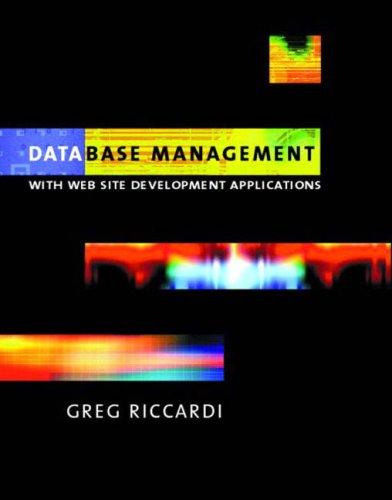Question
1 ASSIGNMENT #2 practice system calls such as fork(), pipe() CS 480 90 points Check Blackboard for due date. Due by 11:59 PM. Write a
1 ASSIGNMENT #2 practice system calls such as fork(), pipe() CS 480 90 points Check Blackboard for due date. Due by 11:59 PM. Write a Linux program in C or C++ which uses fork() to start child process(es), and uses pipe() to do inter-process communication. You will first call pipe() twice to create two pipes for communication among the processes. Let us call them pipe_a and pipe_b, respectively. You will then call fork() twice to create 3 additional processes. Among them, one process is the child of the initial process, but it is also the parent of another process. We call this process Intermediate Parent. The pipe_a is used for communication between the initial process and one of its child processes (the one that is not the intermediate parent). The parent will write a string to the pipe Go do some chores. . And the child will read from it. Similarly, the pipe_b is used for communication between the intermediate parent and the grandchild. The intermediate parent will write a string to the pipe Go do some chores.. And the grandchild will read from it. Each child process or intermediate parent process will print out some information: Child: My PID is xxxx, my parent's PID is yyyy. I read from pipe A: Go do some chores. Child: My PID is xxxx, my parent's PID is yyyy. I read from pipe B: Go do some chores. Intermediate Parent: My PID is xxxx, my parent's PID is yyyy. My child is wwww. I write to pipe B: Go do some chores. After printing this information, the child or intermediate parent process should sleep for 3 seconds, then print the following message and exit: Child zzzz: I am awake. Intermediate Parent xxxx: I am awake. In the (initial) parent process, print the message: Parent: My PID is xxxx, my parent's PID is yyyy. My Children are wwww, zzzz. I write to pipe A: Go do some chores. Then invoke the command ps f -ppid from your program to show all the processes involved. You can use the system() function to do this. After ppid, you must list the PARENT process ids of all the processes you want to list. For example, /bin/ps -f --ppid 26560,26803,26804,26805. See manual for ps command for more details. Also note that you should not use a general ps command here without specifying the parent ids of the processes of interest. If you use system(), which starts another process, you should see 5 processes in the output list (see sample output later). The parent process should wait for all the child processes to complete, then print the following message and exit: 2 Parent: Child processes finished their work. Note that each message is labeled according to the process that printed it, parent or child or intermediate parent. When multiple messages are printed from the same process, they should appear in the order in which they are printed. Each message should be single-spaced with a blank space between messages. An example output: Parent: My PID is 15513, my parent's PID is 15471, my children are 15514, 15515. I write to pipe A: Go do some chores. Parent: Issuing command: /bin/ps -f --ppid 15471,15513,15514,15515 Intermediate Parent: My PID is 15514, my parent's PID is 15513, my child is 15516. I write to pipe B: Go do some chores. Child: My PID is 15516, my parent's PID is 15514. I read from pipe B: Go do some chores. Child: My PID is 15515, my parent's PID is 15513. I read from pipe A: Go do some chores. UID PID PPID C STIME TTY TIME CMD jzhou 15513 15471 0 11:30 pts/2 00:00:00 ./a.out jzhou 15514 15513 0 11:30 pts/2 00:00:00 ./a.out jzhou 15515 15513 0 11:30 pts/2 00:00:00 ./a.out jzhou 15516 15514 0 11:30 pts/2 00:00:00 ./a.out jzhou 15517 15513 0 11:30 pts/2 00:00:00 sh -c /bin/ps -f --ppid 15471,15513,15514,15515 Child: 15516 is awake. Intermediate Parent: 15514 is awake. Child: 15515 is awake. Parent: Child processes finished their work. Note: The interlacing of messages printed by different processes will depend on the timing of your program and does not have to match the example output. Requirement: Use man command to learn usages of the following system calls or functions. Some are useful for this project. getpid( ) getppid( ) wait( ) waitpid( ) execlp( ) system( ) setbuf( ) Output produced by exec/system, which starts a separate subtask, could come out while previously printed output is still in a buffer. To ensure that your outputs come out in sequence, you need to use unbuffered output. Use setbuf(stdout, NULL) at the beginning of your code (of the parent block, if at the top of entire program, cout outputs may be garbled) to get unbuffered output. For every system call you make, check the return value to make sure the call is successful before you proceed. Programs must be consistently indented and commented so that a reasonable person can understand them. Use of descriptive variable names is always encouraged as an aid to readability. Administration: Assignment Link: https://classroom.github.com/a/HzEC3bGs Submit the assignment via github classroom as in prior assignments
Step by Step Solution
There are 3 Steps involved in it
Step: 1

Get Instant Access to Expert-Tailored Solutions
See step-by-step solutions with expert insights and AI powered tools for academic success
Step: 2

Step: 3

Ace Your Homework with AI
Get the answers you need in no time with our AI-driven, step-by-step assistance
Get Started


